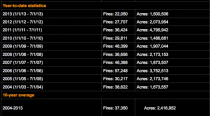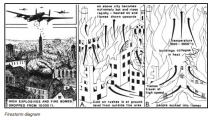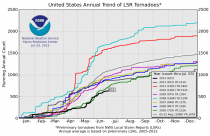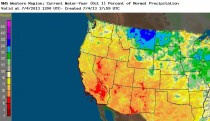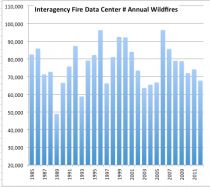“Unless we announce disasters no one will listen.” Sir John Houghton, First chairman of the IPCC
By Joe Bastardi and Joe D’Aleo, Weatherbell.com
Its a sad world today when not only does one have to offer weather explanations for a tragedy, but then have to counter obvious lies that are going to be told about it ( hence the reason I am not optimistic about our nation, because too many people accept, rather than question, what they hear). So the first thing I am going to do is show you the facts about how far below normal we are with Wildfires this year.
W are close to a million acres below the 10 yr running mean over 15,000 fire less than the 10 year running mean, less fires than any of the last 10 years, and next to last in acres burned. And yet the climatic ambulance chasers are already out trying to push a lie on this matter that was born of the tragedy of 19 people losing their lives in the wildfire we have been hearing about.
The most destructive incident of fire I know of, and one that is somewhat infamous in meteorological terms is the Dresden Firestorm. Basically what was done to Japan with the Atom bomb was done to Dresden with mass bombing that created and inferno in the center of the city, and the heat plume that developed allowed air to rush in from cooler outlying areas and created what was a literal firestorm. Historians writing on this question the motives of the allies, since Dresden was not a military city. While not an expert on this it appears the decision to do this was the modern day parallel to Shermans burning of all of Georgia, not just the military part. It may have been to completely demoralize the population by hitting a city that really, was looked at as some place like Switzerland.. not really something that was contributing to the German war effort. In fact the Germans moved what little defense they had of Dresden to other places.
In any case, the diagram below shows what happened
In the case of the wildfire there are two things to consider. The air is hot and dry, and the heating by the fire itself increasing the instability by making it even hotter. This means that winds around the wildfire, which even without a wildfire, are prone to shifting around because of the nature of the pattern and topography, become even more un predictable. This is the second case of experts around an event they are trained for, being overwhelmed by the event, the first being the tornado and its shift and winding up, and now this.
But again listen to the facts. Like the tornado season, this is well below normal, and the fire is sticking out like a sore thumb in the wildfire season, just like the 2 late May tornadoes, its the exception to the rule of the season. In addition the fact that there has NOT BEEN A FIRE IN THE AREA, for 4 years, removing fuel, is contributing to this. Is it dry. Yes. But if it had been a wet spring, then more fuel would have been available as the summers always dry out. In the southwest, its pay me now or pay me later. If its wet, it means that eventually the growth has to die when it dries out. When it dries out, its going to burn eventually. JB
It has ben a dry ‘wet season’ in the west as JB said, Se the percent of normal rain is less than 25% of normal in some areas.
---------------
Hot weather and climate change - a mountain from a molehill?
By Steve Goreham
Originally published in The Washington Times
On Sunday, Death Valley temperatures reached 129F, a new June record high for the United States, according to the National Weather Service. Temperatures at McCarran International Airport in Las Vegas reached 117F, tying the previous record set in 1942 and 2005. National Geographic, NBC News, and other media ran stories attributing the Southwest heat wave to human-caused global warming. But history shows that today’s temperatures are nothing extraordinary.

The United States high temperature record was set in 1913, measured in Death Valley on July 13. Twenty-three of the 50 US state high temperature records date back to the decade of the 1930s. Seventy percent of state high records were set prior to 1970.
The alarm about climate change is all about one degree. According to the National Oceanic and Atmospheric Administration (NOAA), global surface temperatures have increased about 1.3F (0.7C) since 1880. Proponents of the theory of man-made warming claim that this is evidence that man-made greenhouse gases are raising global temperatures.
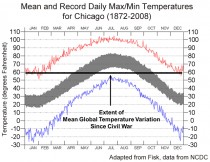
One degree over more than 130 years isn’t very much. In contrast, Chicago temperatures vary from about -5F to 95F, about 100 degrees, each year. When compared to this 100-degree annual swing, the rise in global temperatures since the 1800s is trivial, captured by a thin line on a graph.
Nevertheless, NOAA repeatedly raises concern about global temperatures. The NOAA website proclaims that “May 2013 global temperatures were the third highest on record.” This sounds alarming unless one understands that “on record” refers to the thermometer record, which only dates back to about 1880.
Climate changes over hundreds and thousands of years. Data from ice cores show several periods during the last 10,000 years that were warmer than today, including the Roman Climate Optimum at the height of the Roman Empire and the Medieval Warm Period, when the Vikings settled southwest Greenland. The warm and cool eras since the last ice age were due to natural climate cycles, not greenhouse gas emissions. The “on record” period that NOAA references is only a tiny part of the climatic picture.
Global average temperature is difficult to measure. The data sets of NOAA are an artificial estimate at best. They start with a patchwork collection of thousands of thermometer stations that inadequately cover the globe. Station coverage of the oceans and of the far northern and southern regions is inconsistent and poor. To cover areas without thermometers, averaging estimates are made from surrounding stations to try to fill in the holes.
In addition to coverage problems, gauge measurements often contain large errors. Man-made structures such as buildings and parking lots absorb sunlight, artificially increasing local temperatures. Cars, air conditioners, and other equipment generate heat when operating, creating what is called an Urban Heat Island effect.
The accuracy of the US temperature record is questionable. Meteorologist Anthony Watts, creator of the science website WattsUpWithThat, led a team of volunteers that audited more than 1,000 US temperature gauge stations from 2007 to 2011. Over 70 percent of the sites were found to be located near artificial heating surfaces such as buildings or parking lots, rated as poor or very poor by the site rating system of the National Climatic Data Center, a NOAA organization. These stations were subject to temperature errors as large as 3.6F (2C).
Simple problems can throw off gauge readings. Temperature stations are louvered enclosures that are painted white to reflect sunlight and minimize solar heating. As the station weathers and the paint ages, gauge stations read artificially high temperatures. A study published last month found that after only five years of aging, temperature stations will record a temperature error of 2.9F (1.6C) too high. This is greater than the one degree rise in the last 130 years that NOAA is alarmed about.
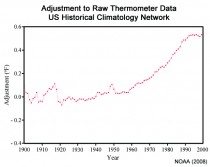
In addition to temperature measurement error, NOAA makes “adjustments” to the raw temperature data. According to a 2008 paper, after raw thermometer data is received, a computer algorithm “homogenizes” the data, adjusting for time-of-observation, station moves, thermometer types, and other factors to arrive at the official temperature data set.
This sounds good until one looks at the adjustment that NOAA has added. For temperature data from 1900 to 1960, very little adjustment is added. But after 1960, NOAA adds an upward adjustment to the thermometer data that rises to 0.5F (0.3C) by the year 2000. This gives a whole new meaning to the phrase “man-made global warming.”
Heat waves are real just as climate change is real. But a heat record in Las Vegas or one degree of temperature rise since the Civil War is not evidence that humans are the cause.
_thumb.jpeg)
Steve Goreham is Executive Director of the Climate Science Coalition of America and author of the new book The Mad, Mad, Mad World of Climatism: Mankind and Climate Change Mania.





